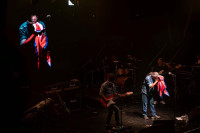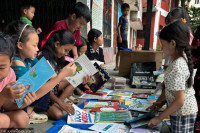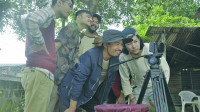Entertainment
Exploring a City Through Art: The Venice Biennale
The Kathmandu Triennale 2017 (KT 2017), held in March this year, which used our city as its canvas, evolved from its two previous iterations as the Kathmandu International Art Festival (KIAF 2009, 2012).
Sophia L Pandé
The Kathmandu Triennale 2017 (KT 2017), held in March this year, evolved from its two previous iterations as the Kathmandu International Art Festival (KIAF 2009, 2012) and used the city, our city, as its canvas. Among other things, the KT was a way for us to see our home anew as objects were placed in familiar places, giving them new perspective, and perhaps invoking fresh ways of seeing and thinking.
The ideal of art is to open our horizons, and banal as that may sound, it is one of the reasons why so many cities have now moved towards versions of art festivals themselves, from Kochi to New York, Basel,and Kathmandu, all emanating from the most prestigious of festivals, the Biennale in Venice, which started in 1895 and happens every two years, bringing millions of visitors to an already wildly popular tourist destination – a feat that every major city would like to emulate.
The Venice Biennale this year, titled “Viva Arte Viva” (Long Live Art)curated by Christine Macel, the Frenchwoman at the helm of the Centre Pompidou, was an unabashed celebration of art and the artist – a refreshing, purposefully naïve approach to art at a time when everything around us is so very cynical and the world is fraught with troubles. In many ways it is extremely satisfying to see such a celebration in a city that is practically immersed in all that is beautiful, almost to a point of brain saturation – showing that the curator and the city do not shy away from the immense legacy that the Biennale has to live up to.
Too vast to describe in detail, the Biennale is split into two major venues, the Arsenale, which is the vast cavern of Venice’s historic, old arsenal storage, and the Giardini, or garden, which houses a central space surrounded by individual country pavilions (many countries pay for the rights to have a building designed to represent their own selected artists) in a lush garden that runs parallel to the coast of the Venetian lagoon. As with all major festivals, the artists and shows on offer are mind-boggling, infuriating, unnerving, good, bad, ugly, beautiful, and everything in between – walking away with even one or two installations that speak to you amidst the brainstorm should render us grateful.
But it is not just the art that Venice offers - with the help of the Biennale we are given the opportunity to discover a city again, for repeat visitors, and certainly to provide another version of this storied city for the novice. Possibly one of the most dreamy cities in the world, it is enhanced, but also brought to earth by the work of hundreds of artists from around the globe.
It is no wonder then that people are now so enamoured of the art festival form. In addition to it opening up yet another market space for the commodification of the arts, it is also a massive revenue earner for the city itself, but bringing with it the immeasurable benefits of art, artists, and art lovers from around the world.
There has been no comprehensive impact survey of what our local art festivals KIAF, KT and Photo Kathmandu – another brilliant crowd-drawer - have brought to the valley, but even an eyeball estimate can show how much interaction they have created between locals, the larger community, visitors, tourists, and art and artists from in and outside the valley.
As we become increasingly more mobile in terms of real travel, side by side with the power of virtual social media to reach across the world, we have also, as a people, become more insular, moving more towards the solipsistic lure of our devices and our own constructions of identity, hardly looking up to see the world around us.
While both Venice and Kathmandu have their fare share of selfie-sticks and selfie takers, here in our valley, we also, as an age old storied repository of Buddhist, Hindu and Animist cultures, have much to offer to the visitor who comes searching for the transcendence that art can sometimes provide if we so choose to engage.
KT and Photo Kathmandu are totally free and open to the public, funded with sweat and tears by their organisers because Kathmandu, and Nepal, has yet to even reach the one million visitors a year mark, unlike Venice which sees twenty million visitors annually, and can charge what they please(asking people to pay to view art in the valley would be totally counterproductive to creating the widespread impact that both local festivals hold dear).
Our challenge is to reap the benefits of these festivals and further invest in them for ourselves, in order to learn from them, and for improved tourism, so that our economy, which relies on this precious income, can benefit. Our own art community can progress, learn, teach, and give back to the world that comes to visit us. At the same time, with every festival, we can pick up our maps and visit venues that we may never go to otherwise, sustaining a phenomenon that was engendered by that first art festival, and will hopefully continue over the coming decades.




 18.12°C Kathmandu
18.12°C Kathmandu










